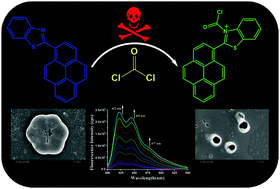A potent colorimetric and fluorogenic phosgene probe based on dual photophysical processes: PET attenuation and ICT reversal†
Abstract
An innocuous fluorescent species, pyrene benzothiazole, PyB, has been found to exhibit outstanding colorimetric and fluorogenic properties toward the estimation of toxic phosgene gas via significant participation of two pivotal photo-physical processes, photoinduced electron transfer (PET) and intramolecular charge transfer (ICT), as manifested through occupation of the lone electron pair on the benzothiazole N atom upon quaternization by phosgene. This is the first report of a phosgene sensor that harnesses most efficiently the charge transfer potential inherent in the sensing platform. In addition, since the basicity of the benzothiazole N atom is not quite sufficient to warrant easy interaction with less acidic chlorides and/or acids than the severely potent phosgene, the probe shows a high degree of selectivity. PyB is amenable to nanomolar (nM) level phosgene sensing through naked eye observation of colour changes in plain daylight as well as the presence of a handheld UV lamp with an appreciably low response time of <50 seconds.



 Please wait while we load your content...
Please wait while we load your content...